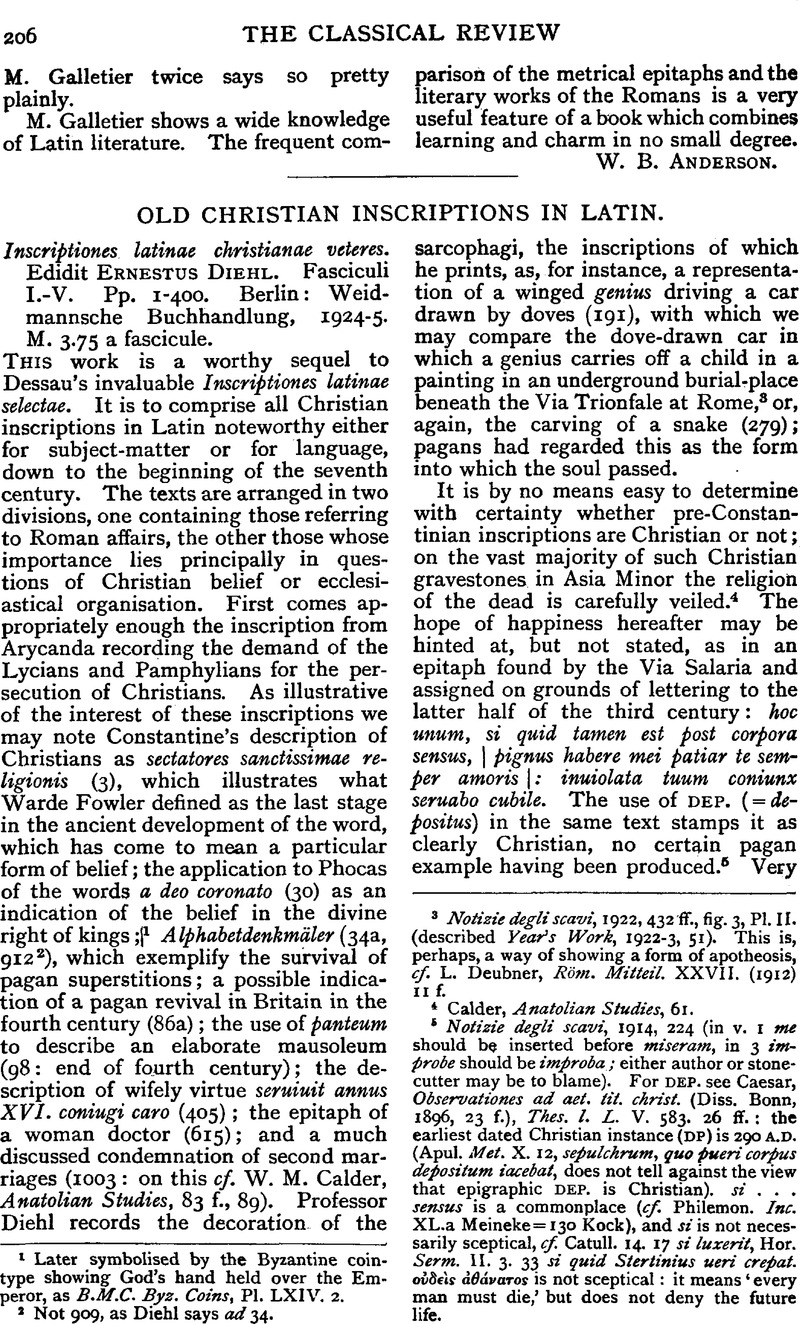Article contents
Old Christian Inscriptions in Latin - Inscriptiones latinae christianae veteres. Edidit Ernestus Diehl. Fasciculi I.–V. Pp. 1–400. Berlin: Weidmannsche Buchhandlung, 1924–1925. M. 3.75 a fascicule.
Published online by Cambridge University Press: 27 October 2009
Abstract

- Type
- Reviews
- Information
- Copyright
- Copyright © The Classical Association 1925
References
page 206 note 1 Later symbolised by the Byzantine cointype showing God's hand held over the Emperor, as B.M.C. Byz. Coins, Pl. LXIV. 2.
page 206 note 2 Not 909, as Diehl says ad 34.
page 206 note 3 Notizie degli scavi, 1922, 432 ff., fig. 3, Pl. II. (described Year's Work, 1922–3, 51). This is, perhaps, a way of showing a form of apotheosis, cf. Deubner, L., Röm. Mitteil. XXVII. (1912) 11 f.Google Scholar
page 206 note 4 Calder, Anatolian Studies, 61.
page 206 note 5 Notizie degli scavi, 1914, 224 (in v. 1 me should be inserted before miseram, in 3 improbe should be improba; either author or stonecutter may be to blame). For DEP. see Caesar, , Observationes ad aet. tit. christ. (Diss. Bonn, 1896, 23 f.)Google Scholar, Thes. I. L. V. 583. 26 ff.: the earliest dated Christian instance (DP) is 290 A.D. (Apul. Met. X. 12, sepulchrum, quo pueri corpus depositum iacebat, does not tell against the view that epigraphic DEP. is Christian). si … sensus is a commonplace (cf. Philemon. Inc. XL.a Meineke=130 Kock), and si is not necessarily sceptical, cf. Catull. 14. 17 si luxerit, Hor. Serm. II. 3. 33 si quid Stertinius ueri crepat. οὐδε⋯ς ⋯θ⋯νατος is not sceptical: it means ‘every man must die,’ but does not deny the future life.
page 207 note 1 Cf. Eitrem-Fridrichsen, Ein christliches Amulett auf Papyrus (Videnskaps-Selskapets Forhandlinger, 1921, i. 26 ff.), and a note by the writer, Folklore, XXXVI., 1925, 94 ff.
page 207 note 2 Adherents of some such sect were perhaps responsible for the paintings in the hypogaeum in the Viale Manzoni at Rome (published in Notizie, 1920 and 1921 and Monutnente Antichi, 1923). It would not be too rash to conjecture that more inscriptions in this collection are due to heretics than the group classed as such (1636–1643).
page 207 note 3 Cavedoni and Kaufmann (Handbuch der altchristlichen Epigraphik, 134) emphasise the importance of the first consideration: for the second cf. 798. 8 Caereris ut iugo Bacchique posse (read posset) teneri, and 787.
- 1
- Cited by




